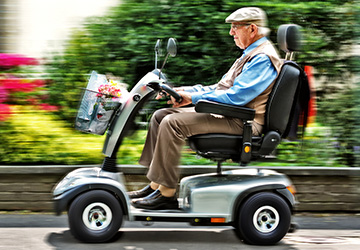THERE’S BEEN LOTS OF TALK lately about motorists showing proper consideration for cyclists, but another hazard is often overlooked.
Mobility scooters offer a new freedom for many people, but they can however pose challenges for other road users. Understanding the challenges on both sides and sharing the road is the key. We are indebted to UK’s IAM RoadSmart and its head of driving and riding standards, Richard Gladman, who shares his advice on driving safely around mobility and electric wheelchair users.
- Be mindful of larger mobility scooters. They can only travel at 15km/h but may be using the road. Give them space and only overtake when it is safe to do so.
- Smaller mobility scooters are restricted to using footpaths and pavements. Dropped kerbs are the only way mobility and electric wheelchair users – not to mention parents with prams – can cross a road easily. It’s also an offence to obstruct these crossing points. When parking consider whether you’re inadvertently making it trickier for a less mobile person to get around.
- Mobility scooters aren’t allowed to use cycle lanes or bus lanes so try not to get impatient if it seems they’re blocking the road – they’re obeying the law.
- While larger scooters must have full lights, the smaller ones intended for pavement use don’t need to. In addition, waterproof covers can affect the vision of the driver. Never assume you’ve been seen. And always double check before pulling out.
- You might be surprised to learn drivers in mobility scooters can technically use dual carriageways. Always expect the unexpected and be prepared for someone around the corner who may be travelling slower than you.
Richard said: “All road users have subtly different challenges and problems tend to arise when these challenges clash. But the groups aren’t mutually exclusive. The driver of a mobility scooter probably used to own a car. The Mum with the buggy might drive a bus for a living. Time is always too short but a bit of understanding of these conflicting needs goes a long way in making us more amicable road users. And a bit of empathy can make us feel better too. Who doesn’t get a warm glow from a friendly thank-you wave from the driver you allowed to go first? Keep an eye out for your fellow road users and improve your own day as well as theirs.”
